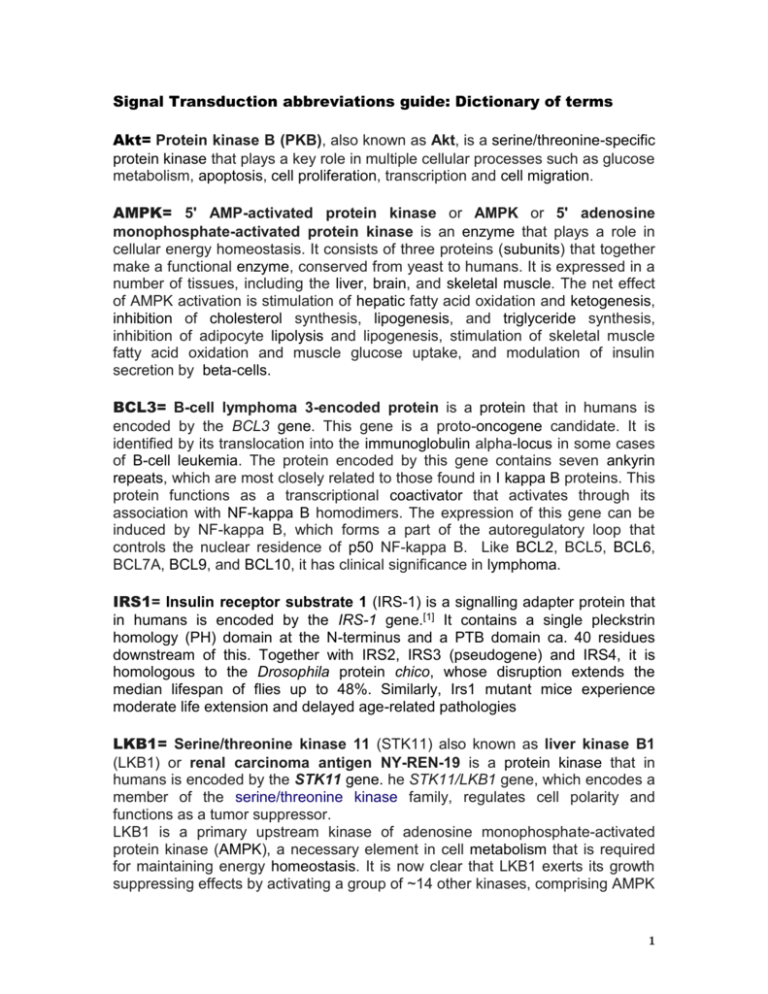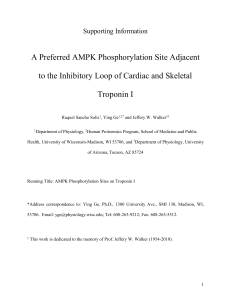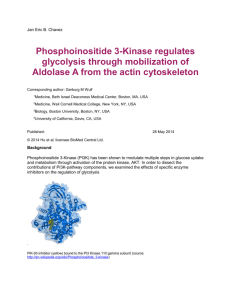Signal Transduction abbreviations guide
advertisement

Signal Transduction abbreviations guide: Dictionary of terms Akt= Protein kinase B (PKB), also known as Akt, is a serine/threonine-specific protein kinase that plays a key role in multiple cellular processes such as glucose metabolism, apoptosis, cell proliferation, transcription and cell migration. AMPK= 5' AMP-activated protein kinase or AMPK or 5' adenosine monophosphate-activated protein kinase is an enzyme that plays a role in cellular energy homeostasis. It consists of three proteins (subunits) that together make a functional enzyme, conserved from yeast to humans. It is expressed in a number of tissues, including the liver, brain, and skeletal muscle. The net effect of AMPK activation is stimulation of hepatic fatty acid oxidation and ketogenesis, inhibition of cholesterol synthesis, lipogenesis, and triglyceride synthesis, inhibition of adipocyte lipolysis and lipogenesis, stimulation of skeletal muscle fatty acid oxidation and muscle glucose uptake, and modulation of insulin secretion by beta-cells. BCL3= B-cell lymphoma 3-encoded protein is a protein that in humans is encoded by the BCL3 gene. This gene is a proto-oncogene candidate. It is identified by its translocation into the immunoglobulin alpha-locus in some cases of B-cell leukemia. The protein encoded by this gene contains seven ankyrin repeats, which are most closely related to those found in I kappa B proteins. This protein functions as a transcriptional coactivator that activates through its association with NF-kappa B homodimers. The expression of this gene can be induced by NF-kappa B, which forms a part of the autoregulatory loop that controls the nuclear residence of p50 NF-kappa B. Like BCL2, BCL5, BCL6, BCL7A, BCL9, and BCL10, it has clinical significance in lymphoma. IRS1= Insulin receptor substrate 1 (IRS-1) is a signalling adapter protein that in humans is encoded by the IRS-1 gene.[1] It contains a single pleckstrin homology (PH) domain at the N-terminus and a PTB domain ca. 40 residues downstream of this. Together with IRS2, IRS3 (pseudogene) and IRS4, it is homologous to the Drosophila protein chico, whose disruption extends the median lifespan of flies up to 48%. Similarly, Irs1 mutant mice experience moderate life extension and delayed age-related pathologies LKB1= Serine/threonine kinase 11 (STK11) also known as liver kinase B1 (LKB1) or renal carcinoma antigen NY-REN-19 is a protein kinase that in humans is encoded by the STK11 gene. he STK11/LKB1 gene, which encodes a member of the serine/threonine kinase family, regulates cell polarity and functions as a tumor suppressor. LKB1 is a primary upstream kinase of adenosine monophosphate-activated protein kinase (AMPK), a necessary element in cell metabolism that is required for maintaining energy homeostasis. It is now clear that LKB1 exerts its growth suppressing effects by activating a group of ~14 other kinases, comprising AMPK 1 and AMPK-related kinases. Activation of AMPK by LKB1 suppresses growth and proliferation when energy and nutrient levels are scarce. Activation of AMPKrelated kinases by LKB1 plays vital roles maintaining cell polarity thereby inhibiting inappropriate expansion of tumor cells. A picture from current research is emerging that loss of LKB1 leads to disorganization of cell polarity and facilitates tumor growth under energetically unfavorable conditions. mTOR= The mechanistic target of rapamycin, also known as mammalian target of rapamycin (MTOR) or FK506-binding protein 12-rapamycinassociated protein 1 (FRAP1), is a protein that in humans is encoded by the MTOR gene. MTOR is a serine/threonine protein kinase that regulates cell growth, cell proliferation, cell motility, cell survival, protein synthesis, autophagy, and transcription. MTOR belongs to the phosphatidylinositol 3-kinase-related kinase protein family. Myc= Myc (c-Myc) is a regulator gene that codes for a transcription factor. The protein encoded by this gene is a multifunctional, nuclear phosphoprotein that plays a role in cell cycle progression, apoptosis and cellular transformation. PTEN= Phosphatase and tensin homolog (PTEN) is a protein that, in humans, is encoded by the PTEN gene. Mutations of this gene are a step in the development of many cancers. PTEN orthologs have been identified in most mammals for which complete genome data are available. This gene was identified as a tumor suppressor that is mutated in a large number of cancers at high frequency. The protein encoded by this gene is a phosphatidylinositol-3,4,5-trisphosphate 3-phosphatase. It contains a tensin-like domain as well as a catalytic domain similar to that of the dual specificity protein tyrosine phosphatases. Unlike most of the protein tyrosine phosphatases, this protein preferentially dephosphorylates phosphoinositide substrates. It negatively regulates intracellular levels of phosphatidylinositol-3,4,5-trisphosphate in cells and functions as a tumor suppressor by negatively regulating Akt/PKB signaling pathway PI3K= Phosphatidylinositol-4,5-bisphosphate 3-kinase (also called phosphatidylinositide 3-kinases, phosphatidylinositol-3-kinases, PI 3kinases, PI(3)Ks, PI-3Ks PI3K(s)) and are a family of enzymes involved in cellular functions such as cell growth, proliferation, differentiation, motility, survival and intracellular trafficking, which in turn are involved in cancer. PI3Ks are a family of related intracellular signal transducer enzymes capable of phosphorylating the 3 positions hydroxyl group of the inositol ring of phosphatidylinositol (PtdIns). The pathway, with oncogene PIK3CA and tumor suppressor PTEN, is implicated in insensitivity of cancer tumors to insulin and IGF1. 2 The PI3K/AKT/mTOR pathway is an intracellular signaling pathway important in regulating the cell cycle. Therefore, it is directly related to cellular quiescence, proliferation, cancer, and longevity. PI3K activation phosphorylates and activates AKT, localizing it in the plasma membrane. AKT can have a number of downstream effects such as activating CREB, inhibiting p27 localizing FOXO in the cytoplasm, activating. PtdIns-3ps, and activating mTOR which can affect transcription of p70 or 4EBP1. There are many known factors that enhance the PI3K/AKT pathway including EGF, shh, IGF-1 insulin, and CaM. The pathway is antagonized by various factors including PTEN, GSK3B, and HB9. In many cancers, this pathway is overactive, thus reducing apoptosis and allowing proliferation. This pathway is necessary, however, to promote growth and proliferation over differentiation of adult stem cells, neural stem cells specifically. It is the difficulty in finding an appropriate amount of proliferation versus differentiation that researchers are trying to determine in order to utilize this balance in the development of various therapies.] Additionally, this pathway has been found to a be a necessary component in neural long term potentiation. P53= Tumor protein p53, also known as p53, cellular tumor antigen p53, phosphoprotein p53, tumor suppressor p53, antigen NY-CO-13, or transformation-related protein 53 (TRP53), is any isoform of a protein encoded by homologous genes in various organisms, such as TP53 (humans) and Trp53 (mice). This homolog (originally thought to be, and often spoken of as, a single protein) is crucial in multicellular organisms, where it prevents cancer formation, thus, functions as a . As such, p53 has been described as "the guardian of the genome" because of its role in conserving stability by preventing genome mutation. VHL= The von Hippel–Lindau tumor suppressor also known as pVHL is a protein that in humans is encoded by the VHL. Mutations of the VHL gene are associated withhe most researched of these targets is HIF1a, a transcription factor that induces the expression of a number of angiogenesis related factors. HIF is necessary for tumor growth because most cancers demand high metabolic activity and are only supplied by structurally or functionally inadequate vasculature. Activation of HIF allows for enhanced angiogenesis, which in turn allows for increased glucose uptake. While HIF is mostly active in hypoxic conditions, VHL-defective renal carcinoma cells show constitutive activation of HIF even in oxygenated environments. 3











